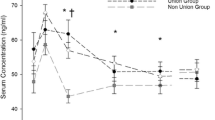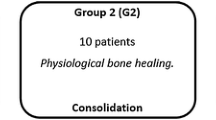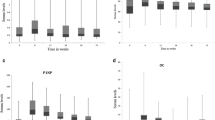Abstract
Objective
Despite adequate treatment 5–30 % of bone fracture patients experience delayed union. During normal fracture union, bone morphogenetic proteins (BMPs) induce healing through a sequential cascade of events. Improved fracture healing after BMP-2 or -7 supplementation in patients with impaired fracture union suggests a deficiency of one or more of these factors. We postulated that low levels of circulating BMPs may result in delayed bone healing. The aim of this study was to quantify differences in levels of circulating BMP-2, -4, -6, -7, and −9 in patients that have demonstrated normal or delayed fracture healing.
Patients and methods
Blood samples were collected from an unselected cohort of 65 patients that had been treated for a diaphyseal tibia or femur fracture. Patients were divided into a group with fracture healing within nine months after injury and a group with delayed fracture union. BMP plasma concentrations were quantified using ELISAs and compared between these two groups.
Results
Circulating plasma levels of BMP-2, -4, -6, and -7 did not differ between 34 patients with normal fracture healing and 31 patients with delayed fracture healing. Also the median BMP-9 plasma levels were not statistically different between the two groups of patients. However, the distribution in the patients with normal union showed a wider range (72–2496 pg/ml) compared with the delayed union group (120–816 pg/ml).
Conclusion
In general, circulating BMP concentrations are not statistically different between patients who demonstrated normal or delayed fracture healing. High circulating BMP-9 levels seem to be associated with faster fracture healing, but are apparently not decisive.

Similar content being viewed by others
References
Gerstenfeld LC, Cullinane DM, Barnes GL, Graves DT, Einhorn TA (2003) Fracture healing as a post-natal developmental process: molecular, spatial, and temporal aspects of its regulation. J Cell Biochem 88:873–884. doi:10.1002/jcb.10435
Tsiridis E, Upadhyay N, Giannoudis P (2007) Molecular aspects of fracture healing: which are the important molecules? Injury 38:S11–S25. doi:10.1016/j.injury.2007.02.006
Tzioupis C, Giannoudis PV (2007) Prevalence of long-bone non-unions. Injury 38:S3–S9
Kanakaris NK, Giannoudis PV (2007) The health economics of the treatment of long-bone non-unions. Injury 38:S77–S84
Lissenberg-Thunnissen SN, de Gorter DJ, Sier CF, Schipper IB (2011) Use and efficacy of bone morphogenetic proteins in fracture healing. Int Orthop 35:1271–1280. doi:10.1007/s00264-011-1301-z
Xiang L, Liang C, Zhen-Yong K, Liang-Jun Y, Zhong-Liang D (2012) BMP9-Induced osteogenetic differentiation and bone formation of muscle-derived stem cells. J Biomed Biotechnol 2012:1–7. doi:10.1155/2012/610952
Kang Q, Sun MH, Cheng H, Peng Y, Montag AG, Deyrup AT, Jiang W, Luu HH, Luo J, Szatkowski JP, Vanichakarn P, Park JY, Li Y, Haydon RC, He TC (2004) Characterization of the distinct orthotopic bone-forming activity of 14 BMPs using recombinant adenovirus-mediated gene delivery. Gene Ther 11:1312–1320. doi:10.1038/sj.gt.3302298
Luu HH, Song WX, Luo X, Manning D, Luo J, Deng ZL, Sharff KA, Montag AG, Haydon RC, He TC (2007) Distinct roles of bone morphogenetic proteins in osteogenic differentiation of mesenchymal stem cells. J Orthop Res 25:665–677. doi:10.1002/jor.20359
Cheng H, Jiang W, Phillips FM, Haydon RC, Peng Y, Zhou L, Luu HH, An N, Breyer B, Vanichakarn P, Szatkowski JP, Park JY, He TC (2003) Osteogenic activity of the fourteen types of human bone morphogenetic proteins (BMPs). J Bone Joint Surg Am 85:1544–1552
Zimmermann G, Henle P, Küsswetter M, Moghaddam A, Wentzensen A, Richter W, Weiss S (2005) TGF-beta1 as a marker of delayed fracture healing. Bone 36:779–785. doi:10.1016/j.bone.2005.02.011
Dimitriou R, Carr IM, West RM, Markham AF, Giannoudis PV (2011) Genetic predisposition to fracture non-union: a case control study of a preliminary single nucleotide polymorphisms analysis of the BMP pathway. BMC Musculoskelet Disord 12:44. doi:10.1186/1471-2474-12-44
Zeckey C, Hildebrand F, Glaubitz LM, Jürgens S, Ludwig T, Andruszkow H, Hüfner T, Krettek C, Stuhrmann M (2011) Are polymorphisms of molecules involved in bone healing correlated to aseptic femoral and tibial shaft non-unions? J Orthop Res 29:1724–1731. doi:10.1002/jor.21443
Szczęsny G, Olszewski WL, Zagozda M, Rutkowska J, Czapnik Z, Swoboda-Kopeć E, Górecki A (2011) Genetic factors responsible for long bone fractures non-union. Arch Orthop Trauma Surg 131:275–281. doi:10.1007/s00402-010-1171-7
Kaiser G, Thomas A, Köttstorfer J, Kecht M, Sarahrudi K (2012) Is the expression of transforming growth factor-Beta1 after fracture of long bones solely influenced by the healing process? Int Orthop 36:2173–2179. doi:10.1007/s00264-012-1575-9
Rosen V (2006) BMP and BMP inhibitors in bone. Ann NY Acad Sci 1068:19–25. doi:10.1196/annals.1346.005
Ren Y, Liu ZZ, Feng J, Wan H, Li JH, Wang H, Lin X (2012) Association of a BMP9 Haplotype with ossification of the posterior longitudinal ligament (OPLL) in a Chinese population. PLoS One 7:e40587. doi:10.1371/journal.pone.0040587
Bidart M, Ricard N, Levet S, Samson M, Mallet C, David L, Subileau M, Tillet E, Feige JJ, Bailly S (2012) BMP9 is produced by hepatocytes and circulates mainly in an active mature form complexed to its prodomain. Cell Mol Life Sci 69:313–324. doi:10.1007/s00018-011-0751-1
Sipe JB, Zhang J, Waits C, Skikne B, Garimella R, Anderson HC (2004) Localization of bone morphogenetic proteins (BMPs)-2, -4, and −6 within megakaryocytes and platelets. Bone 35:1316–1322. doi:10.1016/j.bone.2004.08.020
Acknowledgments
L.J.A.C. Hawinkels is supported by the Dutch Cancer Society/Bas Mulder Award 2011 (UL2011-5051).
Conflict of interest
The authors declare that they have no conflict of interest.
Author information
Authors and Affiliations
Corresponding author
Rights and permissions
About this article
Cite this article
van Baardewijk, L.J., van der Ende, J., Lissenberg-Thunnissen, S. et al. Circulating bone morphogenetic protein levels and delayed fracture healing. International Orthopaedics (SICOT) 37, 523–527 (2013). https://doi.org/10.1007/s00264-012-1750-z
Received:
Accepted:
Published:
Issue Date:
DOI: https://doi.org/10.1007/s00264-012-1750-z




